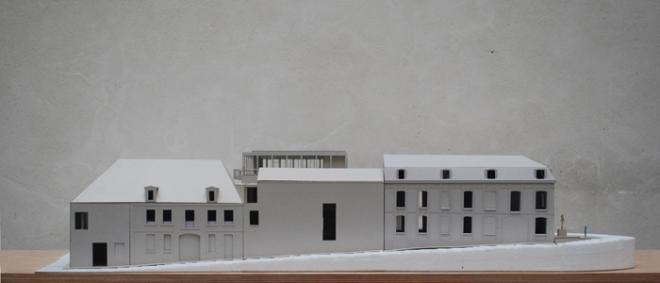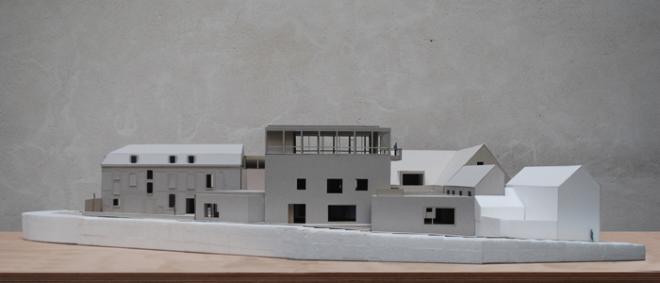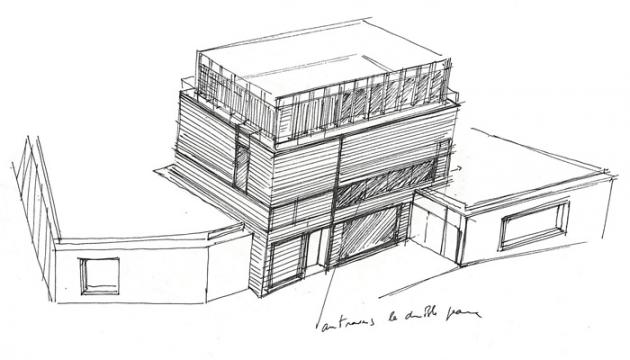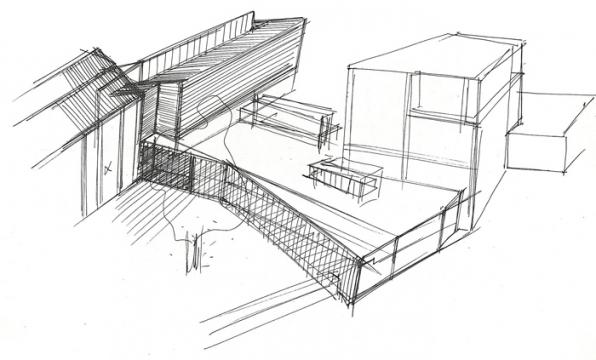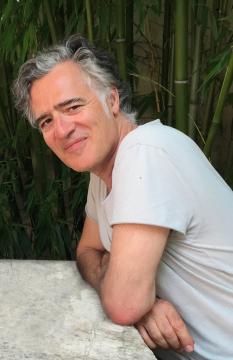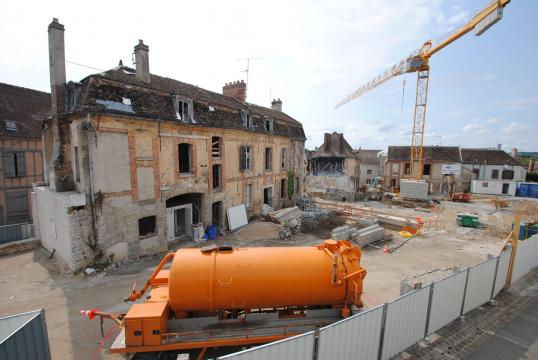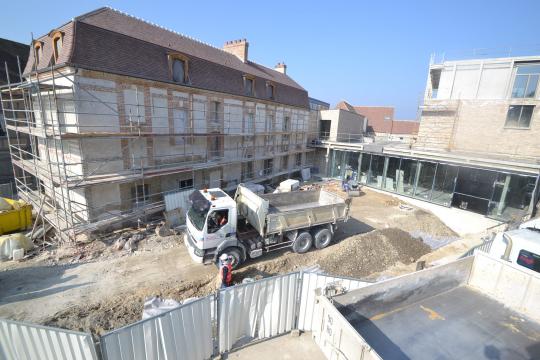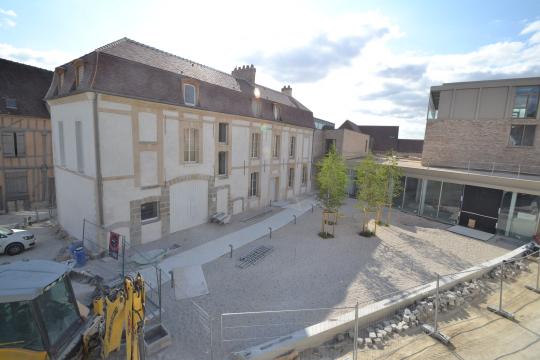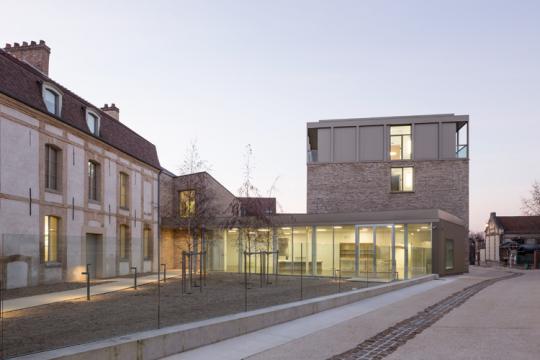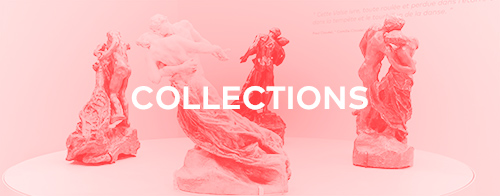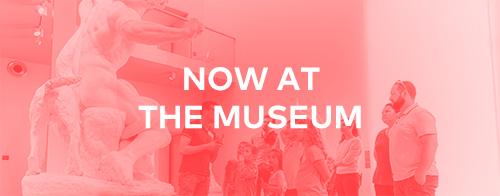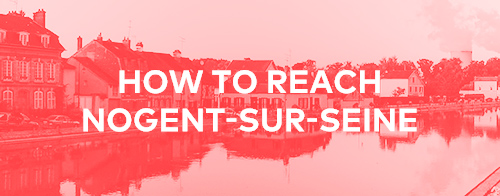1909-1943 : Period of confinement
Spells of delirious paranoia focusing on “Rodin’s band” influence her creative output, to the point of drying it up. She is confined to a mental hospital on 10 March 1913, where she will remain for the rest of her days.
Destructions
1911: Camille Claudel’s physical and mental health worsens, worrying her brother. She shuts herself in.
In a letter to Henriette Thierry (undated, circa 1912), she evokes her destructive tendencies:
“When I received your announcement, I was in such a state of anger that I took all of my wax models and threw them in the fire, it made quite a blaze and I warmed my feet in its glow, that’s what I do when something unpleasant happens to me, I take my hammer and smash up some chap […]
The large statue nearly met the same fate as its little wax sisters, for Henri’s death was followed a few days later by more bad news [...] And many more capital punishments were carried out soon after, with a pile of rubble accumulating in the middle of my studio, it's a veritable human sacrifice."
Correspondances, A. Rivière, B. Gaudichon, Paris 2008.
1913 : confinement
Camille Claudel is not informed of her father’s death on 3 March in Villeneuve-sur-Fère – the father who had ever shown his love for her and protected her. She would therefore not attend his funeral.
On 7 March, Doctor Michaux drafts the confinement certificate for Camille Claudel, who is now 48 years old.
On 10 March, she is confined at Ville-Evrard (in the Val-de-Marne). The procedure adopted is that of “voluntary placement”, as requested by her mother.
Montfavet
She is transferred to the Montdevergues asylum from 5-7 September 1914 due to the war. There she would remain until her death in 1943.
1929: Jessie Lipscomb and her husband visit Camille Claudel during a trip to Europe. This meeting is immortalized by a photograph.
Camille Claudel dies on 19 October 1943, at the age of seventy-eight. Her brother had last visited her on 21 September. She is first buried at the Montfavet cemetery in a temporary tomb, before being transferred to the communal grave.
Reconnaissance
In 1914, while Auguste Rodin is negotiating the establishment of his museum within the Hôtel Biron, on Rue de Varennes, Mathias Morhard requests that he set aside a room for Camille Claudel. Rodin approves the initiative, but Paul Claudel is categorically opposed. Rodin dies on 17 November. His funeral is held at the Villa des Brillants in Meudon, where he is buried.
Between 1934 and 1938, works by Camille Claudel are displayed at the Salon des Femmes Artistes Modernes (“Modern Women Artists Exhibition”).
In 1949, against all expectations, Paul Claudel requests that the Musée Rodin host a retrospective exhibition of his sister’s oeuvre. Cécile Goldsheinder and Paul Claudel work closely together, with the latter authoring the catalogue’s preface entitled “My Sister Camille”, in which he presents a study of her works and an intimate portrait of the artist.
In 1952, Paul Claudel makes an essential donation to the Musée Rodin: the first version of The Age of Maturity in plaster, the second in bronze, The Abandonment in marble and Clotho in plaster.
1893 -1908 : Period of solitary creation
“I have lots of new ideas that would please you enormously (…) I'm greatly enjoying working (…) As you can see, it’s no longer anything like Rodin (…)” These few lines from a letter written by Camille Claudel to her brother in December 1893 reveal her current state of mind.
Break-up with Rodin
1893: Camille Claudel distances herself from Rodin and isolates herself in her work, exasperated by even the most laudatory critics, who hasten to connect her work with that of her master. She would never cease to distance herself, to underline her uniqueness and autonomy. She embarks in new directions and begins her “sketches from life” series inspired by everyday subjects.
Nevertheless, Rodin, at the height of his career, would continue to discreetly support her both financially and within the art world.
In late 1893, Rodin rents the Villa des Brillants in Meudon, to which he moves with Rose Beuret. He would become the owner of the property in 1895.
Rodin succeeds Dalou as president of the sculpture section of the S.N.B.A. and Camille Claudel is made a member.
Exhibition:
S.N.B.A.: The Waltz (n° 37) and Clotho (n° 38)
In 1893, Paul Claudel begins his consular career. He takes up his duties as Vice Consul in New York in April, then as Deputy Consul in Boston in December. Paul’s departure coincides with the start of Camille’s separation from Rodin.
1894: Stay in Guernsey.
Exhibitions:
S.N.B.A: The God in Flight (n° 35) and The Little Chatelaine (bronze, n° 36)
La Libre Esthétique exhibition in Brussels: The Waltz (n° 94), Contemplation (n° 95), Psalm (n° 96) (a bronze cast kept at the Abbeville Museum) and First Step (n° 97)
First commissions
In 1895, Camille Claudel receives two commissions: in January, Clotho in marble to commemorate the banquet held in honour of Puvis de Chavannes, then, in July, her first commission by the French State: The Age of Maturity. Inspector Dayot’s reports allow one to follow the various stages in the elaboration of this major work in the artist’s career. The various models are kept at the Musée Rodin.
In the end, the State would not honour its commission for reasons that remain unclear. As for Clotho, this work would mysteriously disappear from the Musée du Luxembourg.
Exhibition
S.N.B.A.: Camille Claudel exhibits Jeanne as a Child in marble (n° 20), the Bust of Léon Lhermitte in bronze (n° 21), a cast of which is kept at the Nogent Museum, Study of a Japanese in plaster (n° 22) and Confidence in plaster (n° 23).
In June 1895, Paul Claudel departs for Shanghai.
Independence
In 1896, Camille Claudel makes two fateful encounters: Mathias Morhardt, editor at the newspaper Le Temps, and the Countess de Maigret, who would be her main patron up until 1905.
In September, she instructs Mathias Morhardt to convince Rodin to stop visiting her, so as to prove that he has no hand in the creation of her oeuvres.
Exhibitions
S.N.B.A.: The Little Chatelaine, in marble (n° 24 bis)
Art Nouveau exhibition: version of The Waltz in Muller flamed sandstone (kept at the Nogent-sur-Seine Museum).
The Musée Rath in Geneva: plaster of The Gossips, drawn from a marble. A copy is kept at the Nogent-sur-Seine Museum.
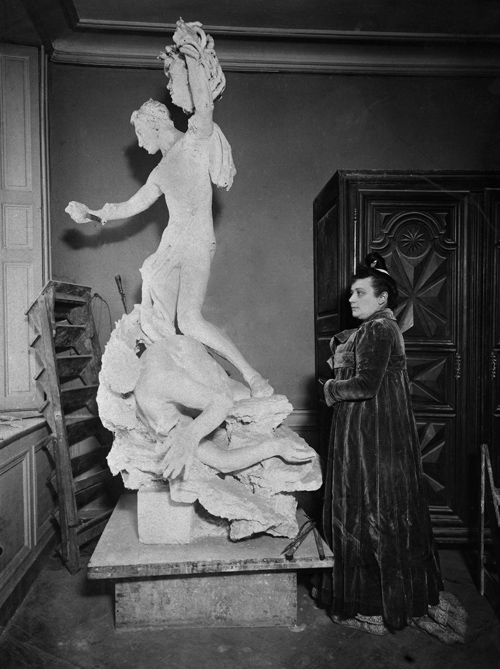
Installation quai Bourbon
1898: In March, Mathias Morhardt publishes in Le Mercure de France the artist's first biography.
Camille Claudel breaks once and for all with Rodin and rents a studio at 63 Rue de Turenne.
Exhibition:
S.N.B.A.: Hamadryade (n° 35), Deep in Thought (n° 36) (a marble and bronze copy kept at the Nogent-sur-Seine Museum), and the Bust of Mr X... (n° 36 bis).
1899: In January, Camille Claudel moves to the Île Saint-Louis, 19 Quai Bourbon, her final lodgings and studio, where she lives and works in reclusion. She is in full possession of her art.
Exhibition
S.N.B.A.: Portrait of Mr the Count of M... (Maigret) in marble (n° 26), Clotho in marble (n° 27), The Age of Maturity in plaster (n° 28) and Perseus in plaster (n° 29).
In June, the commission for The Age of Maturity bronze is drafted but then cancelled for obscure reasons by the Fine Arts Director, Henry Roujon. Camille Claudel holds Rodin responsible for this setback. She meets Captain Tissier, who despite his limited means will allow for the casting of The Age of Maturity, starting with the imploring woman cast by Gruet in 1899.
World's Fair in Paris
World's Fair in Paris: Deep in Thought in marble (n° 139), Dream by the Fire in plaster (n° 140) and Ophelia (Hamadryade) (n° 141).
Salon de la Plume exhibition: Bust of Rodin, in bronze.
Camille Claudel’s meeting with the merchant-editor Eugène Blot (1857-1938) through Gustave Geoffroy, around 1900, would allow for the greater diffusion of her oeuvre. Eugène Blot’s gallery, at 5 Boulevard de la Madeleine, is famous among art enthusiasts. He exhibits the great impressionist artists and himself owns a remarkable collection, with works by such artists as Carrière, Rodin, Renoir, Sysley, Monet, Pissaro and Degas. From his father, he had inherited a foundry still in operation. This encounter would prove essential for the preservation of the artist's oeuvre, given her later propensity to destroy her own sculptures during moments of anguish.
Her brother Paul stays in France from January to September, then returns to China (to the city of Foochow).
1902: Exhibition:
S.N.B.A.: Her final participation in the Société Nationale des Beaux-Arts exhibition with the life-size Perseus in marble (n° 47), Bust of the Countess de Maigret (n° 48), Alsatian, silver-patinated terracotta (n° 49), and cast of The Age of Maturity by Thiebaut Frères for Captain Tissier (kept at the Musée d’Orsay).
1903: Exhibition
Starting from this date, Camille Claudel exhibits her works at either the Salon des Artistes Français or the Salon d’Automne.
S.A.F.: The Age of Maturity, bronze belonging to Captain Tissier (n° 2658).
1904: She befriends Henri Asselin.
Exhibition:
The Salon d’Automne: Fortune (n° 1730), cast by Blot (a copy kept at the Nogent-sur-Seine Museum).
Blot casts The Flute Player (a copy kept at the Nogent-sur-Seine Museum).
Starting in 1904, the art merchant Eugène Blot casts some fifteen bronze copies of her statues.
1905: Paul, having returned from China in April, publishes in July the article "Camille Claudel's Statuary" in the journal L’Occident.
Brother and sister spend part of August together in the Pyrenees. She brings back sketches for a bust of Paul Claudel Aged Thirty-Seven.
Eugène Blot acquires Fortune.
Exhibitions:
S.A.F.: Vertumnus and Pomona, marble (n° 2980) (variation on The Abandonment); The Mermaid, bronze (n° 2981).
The third Salon d’Automne: The Abandonment, bronze.
The Galerie Eugène Blot, from 4 to 16 December: Bernard Hoetger and Camille Claudel.
Already at the first exhibition, in 1905, eleven important bronzes were displayed: Entreaty, in two sizes, Perseus, Dream by the Fire, Fortune, Intimacy, The Old Woman, The Mermaid, The Abandonment, The Waltz and The Gossips. These bronzes are displayed as part of the gallery’s permanent collection and would be regularly exhibited during group events.
During the evening following the inauguration of December 1905, held at Eugène Blot’s home, Camille Claudel loses her temper and makes a scene. Her violent attitude and shocking demonstrations distance her from her loved ones and those who have remained her friends.
1906 – The artist receives a commission from the Department of Fine Arts: a bronze cast of The Wounded Niobid (entrusted to the Fine Arts Museum of Poitiers).
1906 marks the beginning of those periods characterized by the destruction of her sculptures.
Paul Claudel gets married and departs for China.
1907 – The French State purchases, through Eugène Blot, a bronze cast of The Abandonment. (Entrusted to the Cambrai Museum)
Exhibitions:
Galerie Eugène Blot, 11 Rue Richepense, 24 October – 10 November, exhibitions of new sculptures by Camille Claudel and paintings by Manguin, Marquet and Puy. (The Age of Maturity, bronze miniature; Bust of a Young Girl, marble)
Galerie Berheim-Jeune, 16 December 1907 – 4 January 1908: “Portraits of Men”
1908
Exhibition:
Final exhibition at the Galerie Eugène Blot, 1-24 December: Youth and The Age of Maturity (miniature), bronze; Entreaty, bronze; The Abandonment (Vertumnus and Pomona), marble; The Waltz, gilded bronze; Aurora, bronze; Old Man (study for The Age of Maturity), bronze; two busts of women; Perseus, bronze; Fortune, bronze; and The Inspired Woman, original marble.
S.N.B.A.: Portrait of Rodin, lithograph by Hochard based on the work by Camille Claudel.
1886 - 1893 : Rodin and Camille Claudel: a tumultuous love affair and an impassioned, intense artistic dialogue.
While the earliest works by Camille Claudel at the beginning of her intense relationship with Rodin testify to her master’s influence, it is during this relationship that her own personality and the full extent of her talent become apparent.
The two sculptors are closest during this period. Rodin, who considers his young collaborator a great artist, shares with her all of his knowledge and in return enjoys "the happiness of being ever understood, of seeing his expectations ever exceeded". This constitutes “one of the great joys of his artistic life” (Mathias Morhardt).
Stay in England
In the springtime of 1886, Camille Claudel stays with the Lipscombs in Peterborough in England, then in August on the Isle of Wight with Dr Jeans, along with Jessie Lipscomb and Paul Claudel. At Nottingham Castle, she exhibits (with Jessie Lispscomb) the Portrait of Jessie in unbaked clay. She returns to Paris in September, bringing back charcoal drawings.
Upon her return from England, jealous and exclusive Camille Claudel demands of Rodin, in a “contract” signed on 12 October, that he accept no other (female) student but she, that he protect her within the artistic circles and that he marry her following a trip to Italy or Chile. This contract would never be followed up.
Sakountala
In November 1886, Camille Claudel focuses her energy on the creation of a large ensemble inspired by a drama by the Hindu poet Kalidasa: Shakuntala. Begun in the studio at 177 Rue des Petits Champs, this oeuvre would be completed in the studio at 113 Boulevard d’Italie, to which she would move in January 1888. A photograph shows her before the earthen model of the ensemble's young woman, most likely modelled after Jasmina, who is regularly mentioned in her correspondence.
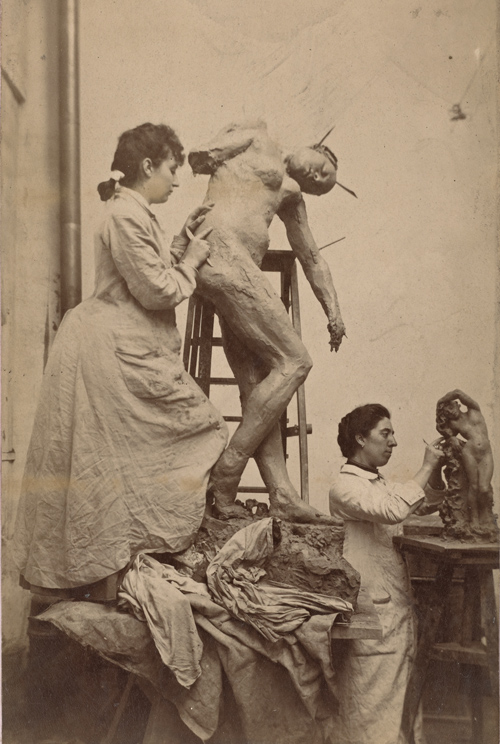
On 8 November 1886, she writes to Florence Jeans:
"I’m now working on my two larger-than-life figures and I have two models per day: a woman in the morning, a man in the evening. You can understand how tired I am: I regularly work 12 hours a day, from 7 in the morning until 7 in the evening, and when I get home, it's impossible for me to remain standing and I go directly to bed."
Engagement of Louise et conversion of Paul
Her sister Louise and Ferdinand de Massary become engaged. They would marry in 1888. Camille Claudel sculpts a bust of Louise the year of their engagement, followed by a bust of Ferdinand de Massary the year of their marriage.
On 25 December, Paul attends Christmas vespers at Notre-Dame de Paris Cathedral and converts to Catholicism.
The Folie-Neubourg and château de l’Islette
1887: Trip to Touraine with Rodin in search of references for the monument to Balzac. They stay at Château de l’Islette in Azay-le-Rideau.
1890 – 1892: Camille Claudel summers at Château de l’Islette in Azay-le-Rideau, where she is joined by A. Rodin.
1888: Rodin rents the Folie-Neubourg au Clos-Payen, n° 68 Boulevard d’Italie, to work alone with Camille Claudel, who in January moves to 113 Boulevard d’Italie (today Boulevard E. Blanqui), located nearly opposite the Clos-Payen. The lease is signed by Rodin.
Exhibition :
S.A.F.: Young Roman (n° 3779) and Young Girl with a Sheaf, in terracotta (kept at the Musée Rodin)
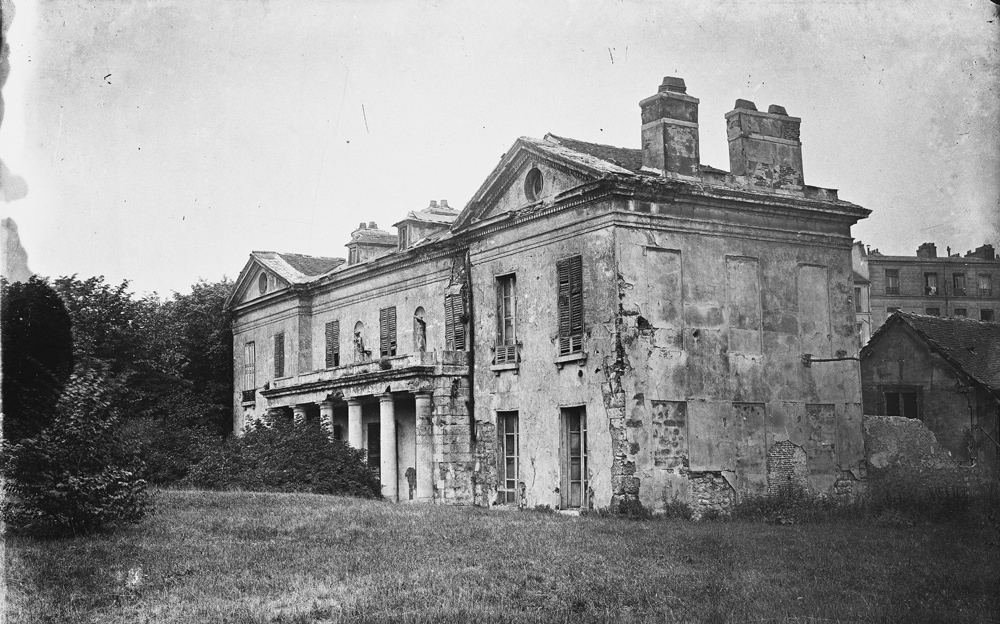
Exhibition
S.A.F.: Shakuntala, plaster, (n° 3930), which earned an honourable mention (kept at the Chateauroux Museum)
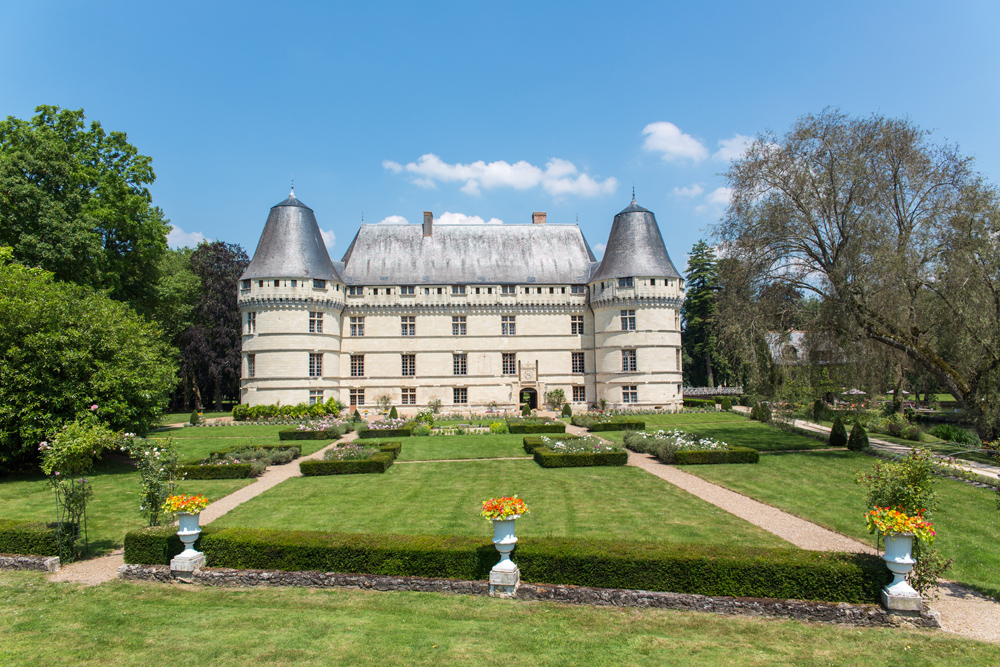
Discovering of Far Eastern art
1889: Camille Claudel discovers Far Eastern art at the World's Fair in Paris, in the company of Claude Debussy. The dazzling pavilion welcomed 596 exhibitors.
Creation of the Société Nationale des Beaux-Arts
Creation of the Société Nationale des Beaux-Arts (“National Society of Fine Art”), which organizes its own exhibition. Rodin is a founding member.
Exhibition:
Exhibition of the Société Nationale des Beaux-Arts: Bust of Charles Lhermitte (n° 4189). A bronze cast is kept at the Nogent-sur-Seine Museum.
A. Rodin and C. Claudel travel to Touraine in July 1889.
Beginning of independence
In 1892, Camille Claudel rents an apartment at 11 Avenue de la Bourdonnais, near the marble depot studio on Rue de l’Université, but keeps her studio on Boulevard d’Italie. The two sculptors grow further apart, both romantically and professionally.
Exhibition:
S.N.B.A.: Bust of Rodin, in bronze (n° 1482). A cast is kept at the Nogent-sur-Seine Museum.
1881-1885 : Her arrival in Paris and encounter with Auguste Rodin: a decisive turning point
Like Alfred Boucher, Rodin is seduced by the exceptional talent of his new student. At the age of 19, she is admitted to his studio as an assistant and rapidly becomes his collaborator, mistress, model and muse.
Moving to Paris
In 1881, Louise Athanaïse Claudel moves with her three children to Paris (135 Boulevard du Montparnasse). She has evidently given in to her husband’s desire to provide their son the opportunity to pursue a higher education. Paul enters the Lycée Louis le Grand, while Camille takes sculpting lessons at the Académie Colarossi (10 Rue de la Grande Chaumière).
Learning with the masters
In 1882, the family lives at 111 Rue Notre-Dame des Champs. Camille Claudel rents a studio at n° 177 of the same street, sharing the rent with other young women, most of whom are English. Alfred Boucher visits once a week to correct their work. Rodin agrees to take over from his friend Alfred Boucher, to whom the Prix du Salon of 1882 offers the opportunity to enjoy a study trip to Italy. In the autumn, the latter departs for Florence.
Alfred Boucher had presented Camille Claudel to Paul Dubois, a native of Nogent-sur-Seine, director of the École des Beaux-Arts fine arts school. Paul Dubois is cited among the young sculptor’s masters in the Salon catalogues, but his role in her apprenticeship at this time remains unknown.
The Old Helen bust dates from this period. The teachings of Alfred Boucher are evident in this work’s naturalistic style.
In Rodin studio
In 1880, the Department of Fine Arts had commissioned Rodin to design the portal to the future Museum of Decorative Arts (The Gates of Hell), to be built on the site of the old Court of Auditors burnt down during the Paris Commune in 1871. This commission allowed him to benefit from a studio at the state marble depot, located on Rue de l’Université, which he would retain for the rest of his life, and obligated him to hire assistants, especially as this commission was soon followed by that for The Burghers of Calais (officially commissioned in January 1885). He would work on this ensemble in his studio at 117 Boulevard de Vaugirard.
Rodin is seduced by the fiery temperament and exceptional talent of his new student. In 1884, she is admitted to his studio as an assistant and rapidly becomes his collaborator, mistress, model and muse. They work together in harmony, sharing studios and models. Her own works betray the influence of her master. Their intense, tormented relationship would have an everlasting effect on both artists.
Jessie Lipscomb, a young English sculptor, arrives in Paris in 1883. She stays with the Claudels, while working at the studio at 177 Rue des Petits Champs.
Exhibition: S.A.F.: Bust of Madame B..., plaster (n° 3474) (whereabouts unknown)
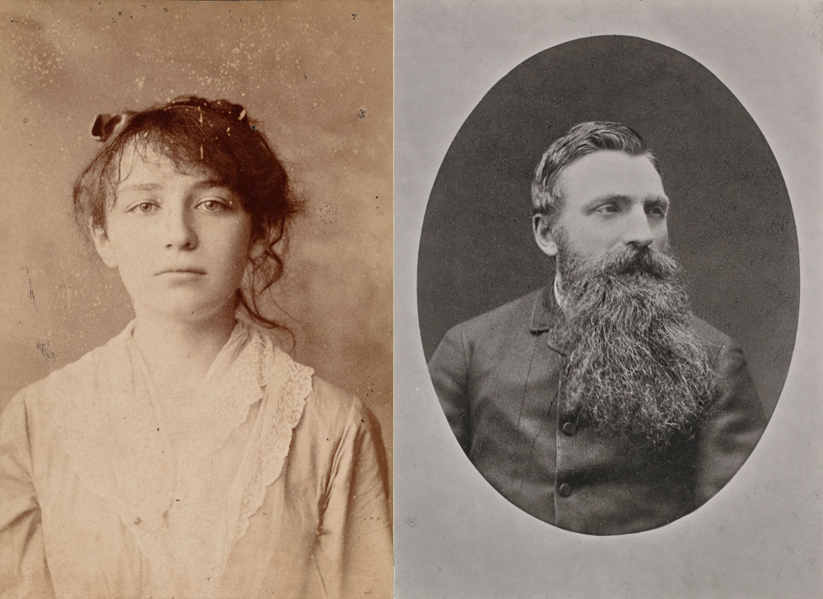
1885: The Claudel family moves to 31 Boulevard de Port-Royal. In April, Camille Claudel registers for the anatomy gallery of the Natural History Museum.
Paul and Camille Claudel attend Mallarmé’s famous Tuesday gatherings.
Exhibition:
S.A.F.: Giganti (n° 3495) (cast at the Nogent-sur-Seine Museum) and Old Helen in terracotta (n° 3497) (kept at the Nogent-sur-Seine Museum)
1876 – 1881: An early vocation discovered and encouraged by Alfred Boucher
It is in Nogent-sur-Seine that young Camille first becomes fascinated in modelling and receives her first lessons by the sculptor Alfred Boucher, moved by her precocious talent. This encounter would prove decisive for her future.
Installation in Nogent-sur-Seine
In the autumn of 1876, Louis-Prosper Claudel is promoted to registrar of mortgages in Nogent-sur-Seine. The couple and their three children move for three years to a fine townhouse dating from the 18th century, today extending out like a prow at the museum entrance.
Camille, Louise and Paul are aged 12, 10 and 8, respectively. Their education is entrusted to a private tutor, Monsieur Colin, who would manage to provide them with a solid formal education.
“Between grammar, arithmetic or history lessons, this studio [the family house] is the centre of general activity. With the help of her younger sister and her young brother, […] Mademoiselle Claudel reigns sovereign. Under her direction, and while she feverishly twists her lumps, one person beats the clay for modelling, a second mixes the plaster, a third poses as a model…” (...)“At this time, she has yet to take a single drawing or modelling lesson. Her only concept of the naked body is that provided by her écorché, and a few engravings from old books. No matter, with a wonderful enterprising spirit, she creates naked forms that seem most credible to her […] Everything she reads inspires sculptural motifs.”
(Mathias Morhardt, « Mademoiselle Camille Claudel », in Mercure de France, Paris, 1898).
It is in Nogent that she models her first earthen figurines: David and Goliath, Bismarck and Napoleon (lost works).
Decisive encounter with Alfred Boucher
At the age of twelve, Camille Claudel demonstrates a remarkable gift for sculpture. Her father, troubled by this vocation evident at such an early age, seeks the advice – most likely through his children’s tutor – of the sculptor Alfred Boucher, who regularly visits his parents still residing in Nogent-sur-Seine. Alfred Boucher is the first to detect her talents, teaching her the rudiments of sculpture and lavishing her with advice. Just recently awarded second prize in sculpture for the Prix de Rome bursary in 1876, Boucher’s judgement carries great weight with Louis-Prosper Claudel. This meeting would prove decisive for the future of the young girl fiercely determined to become a sculptor.
Eugénie Plé, the Claudels’ old servant, remembers :
“Alfred Boucher advising Camille […] to move to the capital"
(Yves Lacasse, Claudel : les œuvres de jeunesse, in the catalogue for the exhibition Claudel – Rodin, p. 22).
But the young girl’s vocation brings her parents into conflict: a female sculptor is a challenging concept in this late 19th century, when a woman must choose between either marriage or a career resulting in solitude and a renunciation of her sexuality.
1864 – 1876: Early childhood in a provincial middle-class family
The Claudel siblings grew up in an insular family, in an atmosphere of constant squabbling, between an abrupt yet loving father attentive to the education of his children and a mother focused on day-to-day concerns and needy of affection.
Fère-en-Tardenois and Bar-le-Duc
Camille Claudel is born on 8 December 1864 in Fère-en-Tardenois (in the Aisne department), where her father, Louis-Prosper Claudel, is a collector of registry fees. He had married Louise-Athanaïse Cervaux in 1862. Camille is the eldest of three children. Her sister Louise is born on 2 February 1866, also in Fère-en-Tardenois, and her brother Paul is born on 6 August 1868 in Villeneuve-sur-Fère, in the presbytery where the family is welcomed in 1866 by the priest, Madame Claudel’s uncle.
In 1870, Louis Prosper Claudel is transferred to Bar-le-Duc (in the Meuse department).There, Camille is instructed by the Sisters of the Christian Doctrine.
Holidays at Villeneuve-sur-Fère
Villeneuve-sur-Fère would remain an important anchoring point for all three children. Camille and Paul would never forget their escapades among the stream of rocks sculpted by the elements, in the very heart of the forest, at the place known as “Le Géyn”.
Every year, they would also spend a few weeks with Louis-Prosper Claudel’s family in the Vosges, on the shore of Lake Gérardmer.
Camille and Paul
The Claudel children are raised within a closed, tense family circle. According to his son, Louis-Prosper Claudel is hard and severe, but honest and devoted to his family. Madame Claudel is occupied all day long with the household chores. “Never a moment to think about herself, nor very much about others", "She never kissed us". The family’s values are work, effort, economy, honesty and a sense of duty. Over the years, Camille and Paul have built up an intense relationship that would last all their lives. They support and encourage one another, becoming very close.
The building
The museum’s major objective is to present the oeuvre of Camille Claudel, with the museum – located in the historic heart of the town of Nogent-sur-Seine – housing the greatest collection ever assembled of this great artist’s works.
A museum-island
In this pre-existing context, our intention was to articulate the preserved edifices with new volumes. This architectural grouping forms an urban island in the heart of town, composing a series of exhibition spaces.
Views are afforded between the exhibition area and the streets bordering the museum, allowing for a conjugation of the site's memory and past with its new functionality.
From an architectural point of view, the museum’s volumes are in harmony with the neighbouring houses and surrounding landscape. Indeed, sitting atop a hillock of the historic town centre, the museum acts as a landmark, alongside the church, the large mills and the power plant that together form the urban silhouette of Nogent-sur-Seine.
Brick
Brick represents the principal building material for the museum.
While the surrounding constructions utilize bricks in a more decorative manner, this material entirely covers the museum’s facades, making the edifice both stand out and blend into its setting.
Comprised of clay, the bricks are related by their plastic nature to the work of the sculptor, who transforms raw matter with his or her hands. For this reason, bricks manufactured according to artisanal methods have been favoured.
Presenting the artist’s oeuvre
Offering an architectural arrangement to best present the oeuvre of Camille Claudel is both the point of departure and the finality of this museum. The museography has been reduced to its simplest expression, to allow the artist’s powerful works to speak for themselves.
Only a harmony of colours has been sought between the floors, paintworks and furnishings, so as to give full and free expression to the oeuvres on exhibit.
Adelfo Scaranello, Architect
June 2015
Contributors from the agency Architectures A. Scaranello: Markus Muller, Lucie Waquet, Martin Quelen, Thibaud Szadel
Partners : MDA Lumière - Stéphanie Daniel (museographic lighting)
From the Dubois-Boucher Museum to the Camille Claudel Museum
The origins of the museum: Alfred Boucher
In 1902, Alfred Boucher was a famous and respected artist who accrued distinctions and public commissions. He spent his time between Aix-les-Bains and Paris where, that year, he opened the “La Ruche” residence to house his less affluent fellow artists. However, he had not forgotten the town in which he had grown up and, still in 1902, he embarked on creating the museum in Nogent-sur-Seine. As soon as it was inaugurated, the collection included a significant number of sculptures, which grew rapidly in the years that followed. In addition to Alfred Boucher’s donations, other sculptors or their heirs have also made donations. Hence, some of the masterpieces in the Camille Claudel Museum were already on display in 1902: Le Souvenir by Paul Dubois, Première Pensée d’amour (First Thought of Love) by Marius Ramus, the busts of his parents by Alfred Boucher. However, the collection is not just about sculpture. Alfred Boucher donated part of his collection of paintings and graphic arts, supplemented by donations from contemporary painters such as the landscape artist Léonce Vaÿsse. Other donors are behind a heterogeneous collection of engravings, antiques, medals, coins... A wide-ranging collection of ceramics is due to the combined generosity of the Sevres Manufactory (792 objects) and Élise Boucher, Alfred Boucher’s wife (54 objects). This exceptional contribution by the Sevres Manufactory was no doubt fostered by Alfred Boucher’s personal connections and is reflected in the very substantial exhibits donated by the Cité de la Céramique for the reopening of the museum in 2017.
Establishment of the first museum in Nogent-sur-Seine
In 1902, the museum was initially set up on the first floor of the “Château”, an old house acquired by the municipality in 1899 that stands in the middle of a public garden. It spread to the second floor in 1903, and in 1905, an old shed located further down was renovated and transformed into a sculpture gallery. It was designed to accommodate such monumental works as Joan of Arc by Paul Dubois and the Monument to Doctor Ollier by Alfred Boucher, which were then added to the collections. This extension helped to establish the institution as a museum of sculpture, even though the painting and archaeology collections continued to grow until the Second World War brought them to a halt. The museum was looted and many of the works in the original collection still remain unaccounted for. After the war, French sculptures of the late 19th and early 20th centuries were completely discredited and remained so for many years. Ultimately, the building reverted to its museum function in 1974 in order to present the findings of local archaeological excavations. Then, in 1978, Jacques Piette was appointed curator and undertook colossal work to inventory, study, restore and showcase the collections. The buildings were renovated and the restored sculpture gallery was opened in 1995.
Birth of the Camille Claudel Museum
In 2003, a Camille Claudel exhibition was organized in Nogent-sur-Seine with the collections compiled by Reine-Marie Paris, the artist’s great-niece, and Philippe Cressent. Its outstanding success - some 40,000 visitors in three months - sparked the idea of setting up a new ambition for the Dubois-Boucher Museum by establishing a substantial Camille Claudel collection. Two initial works were acquired: an Étude pour la Tête d’Hamadryade (2006) and L’Implorante (small model) (2007), then, in 2008, Reine-Marie Paris and Philippe Cressent agreed to sell to the town the collections they had built up over many years of intensive research. The very same year, Perseus and the Gorgon, the artist’s only monumental marble sculpture, was acquired thanks to the patronage of several companies and the State’s participation (Fonds national du patrimoine). Finally, in 2008, the municipality purchased the house where Camille Claudel lived with her parents from 1876 to 1879. The foundations of the Camille Claudel Museum project were laid. Yves Bourel and then, from 2012, Françoise Magny, conceived a project that would combine the presentation of Camille Claudel’s career with a sense of context. The first part of the tour presents a panorama of French sculpture in the era of Camille Claudel, thanks to the Dubois-Boucher museum’s collection and some sixty exhibits donated by fifteen different institutions. The collection has been restored to its former glory thanks to a comprehensive restoration campaign and the interior designed by the architect Adelfo Scaranello.
Amenities for your visit
Cloakroom
Freely accessible cloakrooms are made available during your visit (a 1-euro coin is needed for the locker). For safety reasons, the lockers are opened and emptied each evening. The museum may not be held responsible for any theft or damage.
Audioguides
The Camille Claudel Museum offers guided visits, information sheets about the galleries as well as audio guides providing additional information about the collections. Audio guides, equipped with a magnetic buckle, are available upon request at the Museum's reception desk and allow for accessing the multimedia resources in the course of the visit. They are designed with freedom and conviviality in mind so that everyone can visit at his or her own pace, listening to the commentary that suits the visitor, alone, with family or friends. The Museum offers a wide range of activities for individual visitors and families: discovery and thematic visits, family activities, live show and much more!
Adult audio guides available in French, English and German (free)
Family audio guide available in French only (free)
Mobile application
The mobile application of the Musée Camille Claudel provides users with the audio-guide commentary. We encourage you to download the app before you arrive at the Camille Claudel Museum.

Boutique
The museum boutique offers a selection of books and items related to the oeuvre and life of Camille Claudel and the museum’s sculptural collections: museum guidebooks, exhibition catalogues, postcards, notebooks, etc. The boutique is located near the reception.
Accessible, comfortable visits
Disabled visitors and those accompanying them enjoy priority, no-wait access to the museum. The entrance is located on 10 Rue Gustave Flaubert.
Parking near the museum
Two disabled-only parking spaces are located on Rue de l’Etape au vin.
Admission
Free admission for disabled visitors and persons accompanying them. Disabled visitors enjoy direct access to the entrance checkpoint and are kindly requested to present a valid disability card.
The museum is fully accessible to reduced-mobility visitors. Folding chairs and wheelchairs are made available upon simple request at the museum reception. In addition, audio guides equipped with an induction loop (for the hearing deficient) are also available upon request.
The museum welcomes all proposals for activities destined for disabled visitors, for persons benefitting from charitable, social-reinsertion and literacy programmes, and for persons undergoing medical treatment. The museum also offers tours and activities in LSF (French sign language) for the hearing-impaired.
For more information, please contact the booking office.


